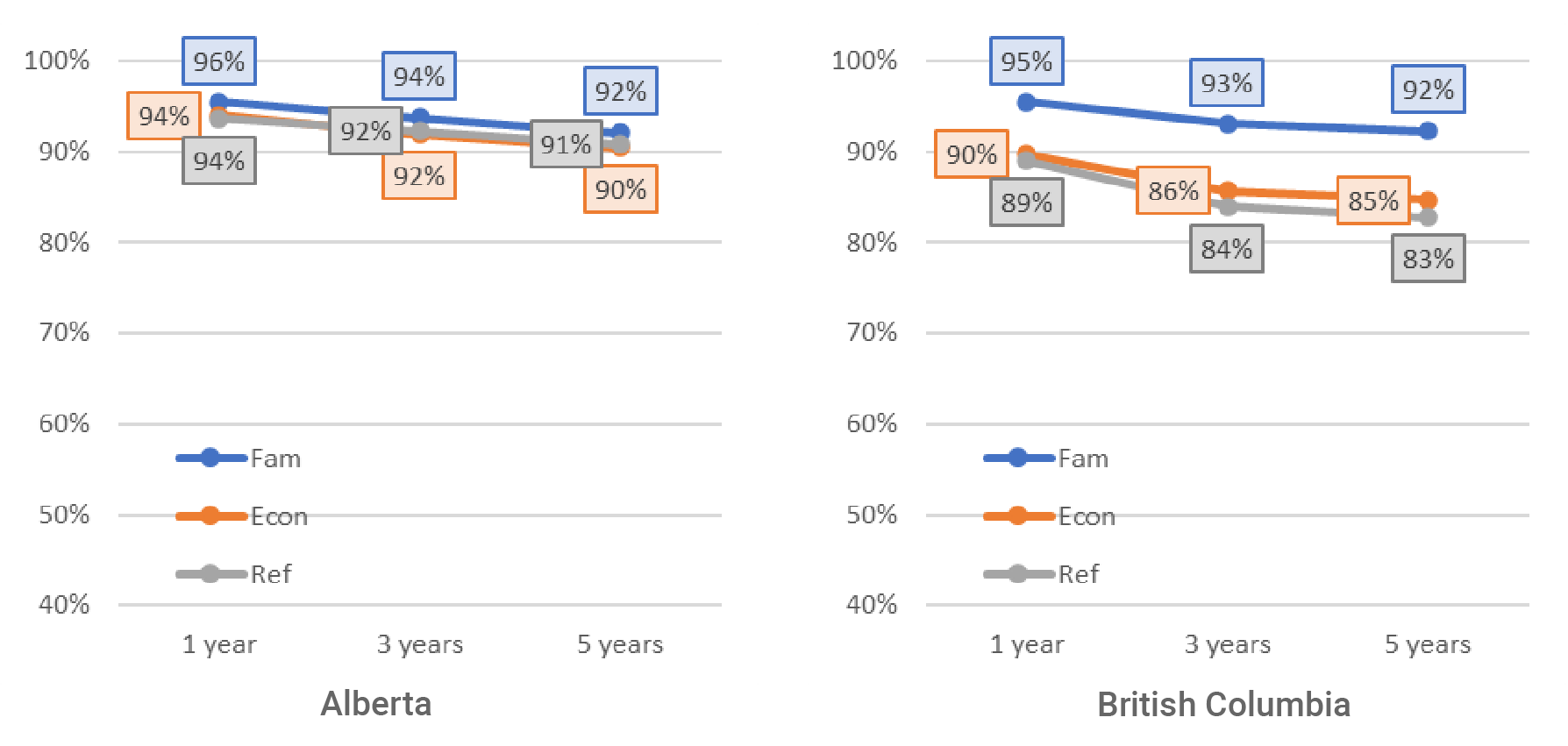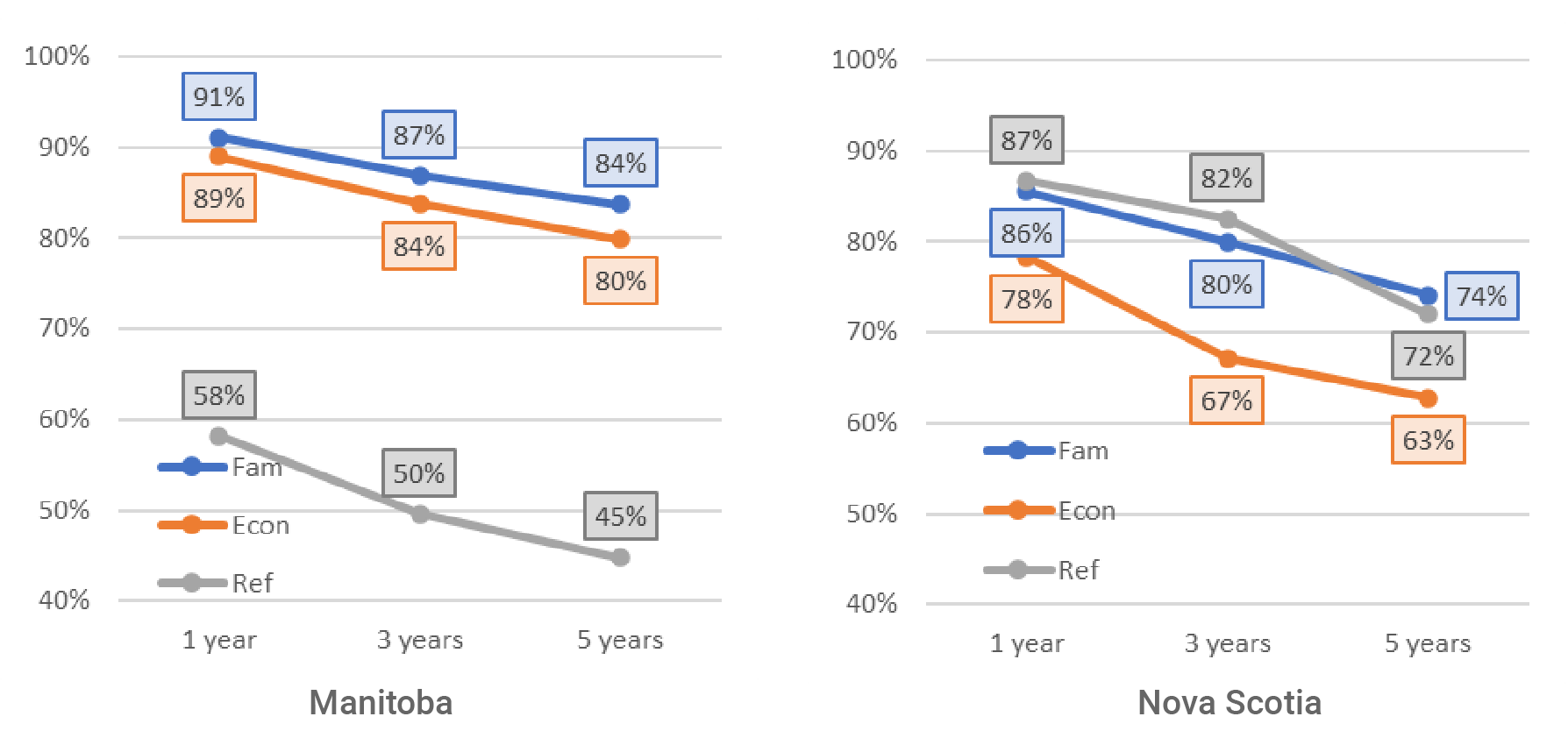Retention Rates -Do refugees stay in the province where they land?
Researchers: Yoko Yoshida1, Jonathan Amoyaw2 and Rachel McLay1
Affiliation: Dalhousie University1 and the University of Saskatchewan2
Keywords: refugees, retention, settlement and integration, British Columbia, Alberta, Manitoba, Nova Scotia, landing cohort, admission category
Go to: Findings, Graphs, Video
Summary
To learn about the well-being of refugees in Canada, examining whether they remain in the province where they first landed or move on to new locales can provide important information about how successfully they are settling into their new environments. This metric, called retention, also helps provinces understand how well programs to assist with refugee settlement and integration are working, and whether new programs and efforts are achieving their intended results.
Using data from the Longitudinal Immigration Database (IMDB), which combines information from immigrants’ landing records with their tax files, it is possible to study the retention of refugees over time. In this report, we use the IMDB 2016 to look at the provincial retention of refugees for three cohorts based on their year of landing in Canada: 2007-2009, 2010-2012, and 2013-2015. This report looks at retention in Nova Scotia, Manitoba, Alberta, and British Columbia. Figures are generated from IMDB data that have been made publicly available by Statistics Canada. This report provides an example of what can be learned through the creation of customized tables using the tools and interactive applications provided on Statistics Canada’s website, found at the following link: https://bit.ly/2BQAytU (This interactive visualization tool provides a useful way of customizing mobility statistics to meet researchers’ needs and interests).
Findings
- Retention rates vary a great deal by province and are typically highest in provinces with major urban centres. Provinces with smaller and more rural populations often struggle to retrain immigrants of all categories, including refugees.
- Alberta shows the highest retention rate, with 91% of refugees in the 2010-2012 cohort remaining there after 5 years.
- Manitoba shows the lowest rates of refugee retention. These rates have decreased over time; five years after landing, Manitoba retained 58% of the 2007-2009 cohort and this declined to 45% for the 2010-2012 cohort of refugees.
- In both Alberta and B.C., retention rates for refugees and economic immigrants tend to be lower than for family class immigrants.
- In Manitoba, the difference in retention between refugees and other immigrant categories is extreme; at 5 years, the retention rate is 84% for family class immigrants and 80% for economic immigrants, but only 45% for refugees.
- In Nova Scotia, economic immigrants show the lowest retention at 63%, while the 5-year retention for refugees is similar to family class immigrants at 72% and 74%, respectively.
Graphs
Figure 1: Refugee retention in Alberta, British Columbia, Manitoba, and Nova Scotia, 2010-2012 cohorts
Figures 2 & 3: Refugee retention in Alberta and British Columbia by landing cohort
Figures 4 & 5: Refugee retention in Manitoba and Nova Scotia by landing cohort
Figures 6 & 7: Retention in Alberta and British Columbia by landing category for 2010-2012 cohort
Figures 8 & 9: Retention in Manitoba and Nova Scotia by landing category for 2010-2012 cohort
- Fig. 1
- Fig. 2 & 3
- Fig. 4 & 5
- Fig. 6 & 7
- Fig. 8 & 9
Figure 1: Refugee retention in Alberta, British Columbia, Manitoba, and Nova Scotia, 2010-2012 cohorts

Retention rates vary a great deal by province, and they are typically highest in provinces with major urban centres. Provinces with smaller and more rural populations often struggle to retain immigrants of all categories, including refugees. Both economic and social factors are important to retention: job opportunities and being near to family, friends, or community provide strong motivations for immigrants to stay in or leave an area. Figure 1 offers a snapshot of the differences in retention observed between Alberta, British Columbia, Manitoba, and Nova Scotia for the 2010-2012 landing cohorts.
Figures 2 and 3: Refugee retention in Alberta and British Columbia by landing cohort
The retention rate of refugees varies by province in important ways. Alberta shows the highest retention, with 91% of refugees in the 2010-2012 cohort remaining in the province after 5 years. British Columbia also shows relatively high rates, at 83% for the 2010-2012 cohort after 5 years. These rates have remained stable across landing cohorts.
Figures 4 and 5: Refugee retention in Manitoba and Nova Scotia by landing cohort

Manitoba shows the lowest rates of refugee retention of all four provinces. These rates have decreased over time; after 5 years of landing, Manitoba retained 58% of the 2007-2009 cohort of refugees, and this declined to 45% for the 2010-2012 cohort. Nova Scotia, meanwhile, retained 66% of refugees who landed in 2007-2009 after 5 years, but this increased to 72% for the 2010-2012 cohort.
Figures 6 and 7: Retention in Alberta and British Columbia by landing category for 2010-2012 cohort

In both Alberta and British Columbia, retention rates for refugees and economic immigrants tend to be lower than for family class immigrants. This difference between categories is greater in British Columbia, where retention rates for family class immigrants are similar to those in Alberta but rates for refugees are about 8 percentage points lower after 5 years—at 83%, compared to 91% in Alberta.
Figures 8 and 9: Retention in Manitoba and Nova Scotia by landing category for 2010-2012 cohort

In Manitoba, the difference in retention between refugees and other immigrant categories is extreme compared to other provinces. At 5 years, the retention rate is 84% for family class immigrants and 80% for economic immigrants, but only 45% for refugees. In Nova Scotia, on the other hand, it is economic immigrants showing the lowest retention, at 63%, while 5-year retention for refugees is nearly as high as for family class immigrants, at 72% and 74%, respectively.
Video
Do refugees stay in the place they arrive?: Presentation for BC Refugee Hub Webinar.
The researchers present their findings on the retention rates of refugees at BC Refugee Hub’s Jan. 2021 Webinar on Refugee Research – National and Local Perspectives.
Explore more projects

